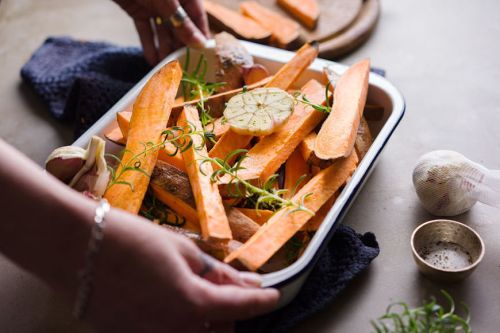Whether you like ’em baked and topped with butter, popped in the toaster and served with avocado on top, or in a big bowl of chili, sweet potatoes have become quite the trendy veggie. (Watch your back, cauliflower.) You’d think buying the tuber would be pretty straight forward. But if you’ve sought them out at the grocery store, you’ve likely come in contact with a common conundrum: seeing them right next to their cousin, the yam. You might not have even noticed the difference. After all, they do look very similar. Which raises an interesting question: what is the difference between sweet potatoes and yams, anyways?
How to use color, shape, and texture to determine the difference between yams and sweet potatoes
Registered dietitian Jessica Cording, RD sees people mixing up sweet potatoes and yams a lot. “Often what people think are yams are actually sweet potatoes,” she says. Visually, she explains that yams are lighter in color and have a light brown, scaly outside. “The flesh is actually whiter,” she says.
As for sweet potatoes, Cording points out that there many different types of sweet potatoes and they can range from the brown on the outside, orange on the inside tubers that are most popular, brown on the outside and purple on the inside, and even red on the outside and white on the inside—also known as Japanese sweet potatoes. Sweet potatoes also have sinched ends, while yams are rounded on the edges like classic potatoes. In other words, when in doubt, you are most likely looking at a sweet potato and not a yam.
How the two compare nutritionally
Nutritionally, Cording says yams and sweet potatoes—in all their various types—are pretty similar. “Both are starchy vegetables that are good sources of potassium and fiber,” she says. Sweet potatoes and yams also both have zinc (vital for cell growth and immune function), magnesium (important for muscle function, heart health, and immunity), iron (essential for blood production), and selenium (which protects cells from being damaged).
There are some slight differences in the nutrition department, however. Cording says the big one is that sweet potatoes are higher in beta carotene. “You can see this in sweet potatoes’ vibrant pigments,” she says. “Foods that are orange or purple tend to be very high in beta carotene, unlike paler foods, like yams.” She explains that the major reason why beta carotene is a positive is because the body converts it into vitamin A, which is good for eye health, and the immune system.
Cording says the bright colors of sweet potatoes are also a sign that they are high in antioxidants, something yams are lower in. Antioxidants help reduce inflammation by helping the body fight free radicals, making them another major health perk.
This all doesn’t mean that yams are unhealthy by any standards—they typically have more potassium and fiber than their sweet potato cousins. “When you look at the nutritional data, the differences aren’t huge,” Cording says.
How to use yams and sweet potatoes
Given that their nutritional profiles are both pretty impressive, choosing between sweet potatoes and yams all comes down to your personal taste preferences and how you’re going to use them. Yams, Cording explains, are a bit more savory than sweet potatoes, so it’s important to think about the type of flavor profile you’re going for. “Yams are a little drier and starchier, which might work better for dishes where you’re looking for that texture, like an oven-baked yam pie,” she says. “But if you’re looking for something fleshy and creamy, a baked sweet potato might be a better way to go.”
If you’re looking for some specific recipes to try (because why not?), why not use them both together as in this Thai yam and sweet potato curry? And maybe we’re biased, but this sweet potato gnocchi from The Well+Good Cookbook is to die for.
When it comes down to cooking with sweet potatoes and yams, Cording says her best advice is to experiment to see what you like best. “Mixing it up is good, and trying different flavor combinations is a good way to eat healthy but not feel like you’re stuck in rut or a clean eating box,” she says. So next time you’re in the produce section, why not pick up both?
This post was originally published on April 29, 2019; updated on June 18, 2020.
Sign Up for Our Daily Newsletter
Get all the latest in wellness, trends, food, fitness, beauty, and more delivered right to your inbox.
Got it, you've been added to our email list.











